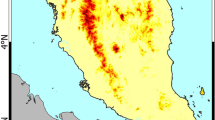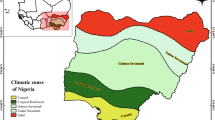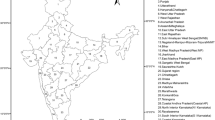Abstract
Increased frequency and severity of heat wave is one of the immediate and certain impacts of rising temperature due to global warming. A number of heat wave related indices considering both daily maximum and minimum temperature are proposed in this paper to assess the changes in different characteristics of heat waves in Pakistan, which is one of the most vulnerable countries of the world to extreme temperature. Gridded daily temperature dataset of Princeton’s Global Meteorological Forcing for the period 1948–2010 was used for this purpose. The results revealed daily maximum temperature more than 95-th percentile threshold for consecutive 5 days or more can well reconstruct the spatial pattern of heat wave in Pakistan. The results revealed that intense heat waves in Pakistan are mostly occurred in the southwest. However, heat waves are most devastating when those occur in highly populated southeast region. It was found that major heat waves in Pakistan occurred in 1952, 1978, 1984, 1988, 2002, 2006, 2009 and 2010 which affected 55.7, 71.1, 74.0, 72.3, 48.9, 60.6, 41.8 and 82.9% population respectively. The trends in heat wave indices revealed significant increases in the indices calculated based on both the maximum and minimum temperatures. Duration of heat wave was found to increase at a rate of 0.71 days/decade, while the duration and affected area having both maximum and minimum temperature above 95-th percentiles are found to increase at a rate of 0.95 days/decade and 1.36% of total area of Pakistan per decade respectively.













Similar content being viewed by others
References
Aadhar S, Mishra V (2017) High-resolution near real-time drought monitoring in South Asia. Sci Data 4:170145
Abaurrea J, Asín J, Cebrián AC (2015) Modeling and projecting the occurrence of bivariate extreme heat events using a non-homogeneous common Poisson shock process. Stoch Env Res Risk Assess 29(1):309–322
Abbas F (2013) Analysis of a historical (1981–2010) temperature record of the Punjab province of Pakistan. Earth Interact 17(15):1–23
Ahmed K, Shahid S, Harun SB (2014) Spatial interpolation of climatic variables in a predominantly arid region with complex topography. Environ Syst Decis 34(4):555–563
Ahmed K, Shahid S, Ali RO, Harun SB, Wang XJ (2017) Evaluation of the performance of gridded precipitation products over Balochistan Province, Pakistan. Desalination 1:14
Aich V, Akhundzadah NA, Knuerr A, Khoshbeen AJ, Hattermann F, Paeth H, Paton EN (2017) Climate change in afghanistan deduced from reanalysis and coordinated regional climate downscaling experiment (CORDEX)—South Asia simulations. Climate 5(2):38
Alexander L (2015) Introduction to heatwave indices, defining and measuring heat waves. https://www.wmo.int/pages/prog/wcp/ccl/opace/opace4/meetings/documents/fiji2015/D3-5-Alexander_heatwaves.pdf
Aloysius N, Saiers J (2017) Simulated hydrologic response to projected changes in precipitation and temperature in the Congo River basin. Hydrol Earth Syst Sci 21(8):4115
Anderson GB, Bell ML (2011) Heatwaves in the United States: mortality risk during heatwaves and effect modification by heatwave characteristics in 43 US communities. Environ Health Perspect 119(2):210
Araghi A, Mousavi-Baygi M, Adamowski J (2016) Detection of trends in days with extreme temperatures in Iran from 1961 to 2010. Theoret Appl Climatol 125(1–2):213–225
Aslam AQ, Ahmad SR, Ahmad I, Hussain Y, Hussain MS (2017) Vulnerability and impact assessment of extreme climatic event: a case study of southern Punjab, Pakistan. Sci Total Environ 580:468–481
Asokan SM, Rogberg P, Bring A, Jarsjö J, Destouni G (2016) Climate model performance and change projection for freshwater fluxes: comparison for irrigated areas in Central and South Asia. J Hydrol Reg Stud 5:48–65
Azhar GS, Mavalankar D, Nori-Sarma A, Rajiva A, Dutta P, Jaiswal A, Hess JJ (2014) Heat-related mortality in India: excess all-cause mortality associated with the 2010 Ahmedabad heatwave. PLoS ONE 9(3):e91831
Badr HS, Zaitchik BF, Dezfuli AK (2014) HiClimR: hierarchical climate regionalization. Comprehensive R archive network (CRAN). http://cran.r-project.org/package5HiClimR
Braganza K, Karoly D, Hirst A, Mann M, Stott P, Stouffer R, Tett S (2003) Simple indices of global climate variability and change: part I-variability and correlation structure. Clim Dyn 20(5):491–502
Buscail C, Upegui E, Viel JF (2012) Mapping heatwave health risk at the community level for public health action. Int J Health Geograph 11(1):38
Cao Q, Yu D, Georgescu M, Wu J, Wang W (2018) Impacts of future urban expansion on summer climate and heat-related human health in eastern China. Environ Int 112:134–146
Chakraborty A, Seshasai MVR, Rao SK, Dadhwal VK (2017) Geo-spatial analysis of temporal trends of temperature and its extremes over India using daily gridded (1° × 1°) temperature data of 1969–2005. Theoret Appl Climatol 130(1–2):133–149
Chaney NW, Sheffield J, Villarini G, Wood EF (2014) Development of a high-resolution gridded daily meteorological dataset over sub-Saharan Africa: spatial analysis of trends in climate extremes. J Clim 27(15):5815–5835
Chen Y, Li Y (2017) An inter-comparison of three heat wave types in China during 1961–2010: observed basic features and linear trends. Sci Rep 7:45619
Cheng J, Xu Z, Bambrick H, Su H, Tong S, Hu W (2018) Heatwave and elderly mortality: an evaluation of death burden and health costs considering short-term mortality displacement. Environ Int 115:334–342
De Bono A, Peduzzi P, Kluser S, Giuliani G (2004) Impacts of summer 2003 heat wave in Europe. https://archive-ouverte.unige.ch/unige:32255/ATTACHMENT01.pdf
del Rio S, Anjum Iqbal M, Cano-Ortiz A, Herrero L, Hassan A, Penas A (2013) Recent mean temperature trends in Pakistan and links with teleconnection patterns. Int J Climatol 33(2):277–290
Duan Z, Liu J, Tuo Y, Chiogna G, Disse M (2016) Evaluation of eight high spatial resolution gridded precipitation products in Adige Basin (Italy) at multiple temporal and spatial scales. Sci Total Environ 573:1536–1553
Fischer EM, Schär C (2010) Consistent geographical patterns of changes in high-impact European heatwaves. Nat Geosci 3(6):398
Hallegatte S, Hourcade JC, Dumas P (2007) Why economic dynamics matter in assessing climate change damages: illustration on extreme events. Ecol Econ 62(2):330–340
Hamed KH (2008) Trend detection in hydrologic data: the Mann–Kendall trend test under the scaling hypothesis. J Hydrol 349(3–4):350–363
Im ES, Pal JS, Eltahir EA (2017) Deadly heatwaves projected in the densely populated agricultural regions of South Asia. Sci Adv 3(8):e1603322
IPCC (2013) Climate change 2013: the physical science basis. In: Stocker TF, Qin D, Plattner G-K, Tignor M, Allen SK, Boschung J, Nauels A, Xia Y, Bex V, Midgley PM (eds) Contribution of working group I to the fifth assessment report of the intergovernmental panel on climate change. Cambridge University Press, Cambridge
Iqbal MA, Penas A, Cano-Ortiz A, Kersebaum KC, Herrero L, Del Río S (2016) Analysis of recent changes in maximum and minimum temperatures in Pakistan. Atmos Res 168:234–249
Islam S, Rehman N, Sheikh MM (2009) Future change in the frequency of warm and cold spells over Pakistan simulated by the PRECIS regional climate model. Clim Change 94(1–2):35–45
Jahangir M, Ali SM, Khalid B (2016) Annual minimum temperature variations in early 21st century in Punjab, Pakistan. J Atmos Solar Terr Phys 137:1–9
Jiang Z, Ma T, Wu Z (2012) China coldwave duration in a warming winter: change of the leading mode. Theoret Appl Climatol 110(1–2):65–75
Karoly DJ, Braganza K, Stott PA, Arblaster JM, Meehl GA, Broccoli AJ, Dixon KW (2003) Detection of a human influence on North American climate. Science 302(5648):1200–1203
Khan N, Shahid S, Bin Ismail T, Wang XJ (2018) Spatial distribution of unidirectional trends in temperature and temperature extremes in Pakistan. Theoret Appl Climatol 41:1–15
Khattak MS, Ali S (2015) Assessment of temperature and rainfall trends in Punjab province of Pakistan for the period 1961–2014. J Himal Earth Sci 48(2):42–61
Kim DW, Deo RC, Lee JS, Yeom JM (2017) Mapping heatwave vulnerability in Korea. Nat Hazards 89(1):35–55
Koutsoyiannis D (2003) Climate change, the Hurst phenomenon, and hydrological statistics. Hydrol Sci J 48(1):3–24
Kovats RS, Kristie LE (2006) Heatwaves and public health in Europe. Eur J Pub Health 16(6):592–599
Kunkel K (2016) Updated version of figure 2.3 in: CCSP (US climate change science program). 2008. Synthesis and Assessment Product 3.3: Weather and climate extremes in a changing climate. www.globalchange.gov/browse/reports/sap-33-weather-and-climate-extremes-changing-climate
Mahmood R, Babel MS (2013) Evaluation of SDSM developed by annual and monthly sub-models for downscaling temperature and precipitation in the Jhelum basin, Pakistan and India. Theoret Appl Climatol 113(1–2):27–44
Manning CD, Schütze H, Raghavan P (2008) Introduction to information retrieval, vol 39. Cambridge University Press
Masood I, Majid Z, Sohail S, Zia A, Raza S (2015) The deadly heatwave of Pakistan. Int J Occup Environ Med 6(4 October):672–678
Meehl GA, Tebaldi C (2004) More intense, more frequent, and longer lasting heatwaves in the 21st century. Science 305(5686):994–997
Miralles DG, Teuling AJ, Van Heerwaarden CC, de Arellano JVG (2014) Mega-heatwave temperatures due to combined soil desiccation and atmospheric heat accumulation. Nat Geosci 7(5):345
Nairn JR, Fawcett RG (2013) Defining heatwaves: heatwave defined as a heat-impact event servicing all community and business sectors in Australia. Centre for Australian Weather and Climate Research
Nairn JR, Fawcett RJ (2014) The excess heat factor: a metric for heatwave intensity and its use in classifying heatwave severity. Int J Environ Res Public Health 12(1):227–253
Nashwan MS, Shahid S, Rahim NA (2018) Unidirectional trends in annual and seasonal climate and extremes in Egypt. Theoret Appl Climatol 10:1–17
Nasim W, Amin A, Fahad S, Awais M, Khan N, Mubeen M, Ahmad S (2018) Future risk assessment by estimating historical heat wave trends with projected heat accumulation using SimCLIM climate model in Pakistan. Atmospheric Research
Nissan H, Burkart K, Coughlan de Perez E, Van Aalst M, Mason S (2017) Defining and predicting heatwaves in Bangladesh. J Appl Meteorol Climatol 56(10):2653–2670
Onyutha C, Willems P (2017) Influence of spatial and temporal scales on statistical analyses of rainfall variability in the River Nile basin. Dyn Atmos Oceans 77:26–42
Orth R, Zscheischler J, Seneviratne SI (2016) Record dry summer in 2015 challenges precipitation projections in Central Europe. Sci Rep 6:28334
Otto FE, Massey N, Oldenborgh GJ, Jones RG, Allen MR (2012) Reconciling two approaches to attribution of the 2010 Russian heat wave. Geophys Res Lett 39(4):L04702
Panda DK, AghaKouchak A, Ambast SK (2017) Increasing heatwaves and warm spells in India, observed from a multiaspect framework. J Geophys Res Atmos 122(7):3837–3858
Patz JA, Campbell-Lendrum D, Holloway T, Foley JA (2005) Impact of regional climate change on human health. Nature 438(7066):310
Peng RD, Bobb JF, Tebaldi C, McDaniel L, Bell ML, Dominici F (2011) Toward a quantitative estimate of future heat wave mortality under global climate change. Environ Health Perspect 119(5):701
Perkins SE (2015) A review on the scientific understanding of heatwaves—their measurement, driving mechanisms, and changes at the global scale. Atmos Res 164:242–267
Perkins SE, Alexander LV (2013) On the measurement of heatwaves. J Clim 26(13):4500–4517
Perkins-Kirkpatrick SE, Gibson PB (2017) Changes in regional heatwave characteristics as a function of increasing global temperature. Sci Rep 7(1):12256
Pezza AB, Van Rensch P, Cai W (2012) Severe heat waves in Southern Australia: synoptic climatology and large scale connections. Clim Dyn 38(1–2):209–224
Rauf S, Bakhsh K, Abbas A, Hassan S, Ali A, Kächele H (2017) How hard they hit? Perception, adaptation and public health implications of heatwaves in urban and peri-urban Pakistan. Environ Sci Pollut Res 24(11):10630–10639
Revadekar JV, Hameed S, Collins D, Manton M, Sheikh M, Borgaonkar HP, Baidya S (2013) Impact of altitude and latitude on changes in temperature extremes over South Asia during 1971–2000. Int J Climatol 33(1):199–209
Robinson PJ (2001) On the definition of a heatwave. J Appl Meteorol 40(4):762–775
Saeed F, Almazroui M, Islam N, Khan MS (2017) Intensification of future heatwaves in Pakistan: a study using CORDEX regional climate models ensemble. Nat Hazards 87(3):1635–1647
Saleem F, Adrees M, Abbas F, Ibrahim M, Zeng X (2017) Changing trend of percentile-based temperature indices over Pakistan. In: EGU general assembly conference abstracts, vol 19, p 1003
Salman SA, Shahid S, Ismail T, Rahman NBA, Wang X, Chung ES (2017) Unidirectional trends in daily rainfall extremes of Iraq. Theor Appl Climatol 5:1–13
Sanderson MG, Economou T, Salmon KH, Jones SE (2017) Historical trends and variability in heat waves in the United Kingdom. Atmosphere 8(10):191
Sen PK (1968) Estimates of the regression coefficient based on Kendall’s tau. J Am Stat Assoc 63(324):1379–1389
Shahid S (2010) Probable impacts of climate change on public health in Bangladesh. Asia Pac J Public Health 22(3):310–319
Shahid S, Harun SB, Katimon A (2012) Changes in diurnal temperature range in Bangladesh during the time period 1961–2008. Atmos Res 118:260–270
Sheffield J, Wood EF (2007) Characteristics of global and regional drought, 1950–2000: analysis of soil moisture data from off-line simulation of the terrestrial hydrologic cycle. J Geophys Res Atmos 112(D17):1
Sheffield J, Goteti G, Wood EF (2006) Development of a 50-year high-resolution global dataset of meteorological forcings for land surface modeling. J Clim 19(13):3088–3111
Sheffield J, Wood EF, Roderick ML (2012) Little change in global drought over the past 60 years. Nature 491(7424):435
Sheikh MM, Manzoor N, Ashraf J, Adnan M, Collins D, Hameed S, Islam N (2015) Trends in extreme daily rainfall and temperature indices over South Asia. Int J Climatol 35(7):1625–1637
Singh M, Rao M, Butler CD (2016) Climate change, health and future well-being in South Asia. In: Akhtar R (ed) Climate change and human health scenario in South and Southeast Asia. Springer, Cham, pp 11–27
Stedman JR (2004) The predicted number of air pollution related deaths in the UK during the August 2003 heatwave. Atmos Environ 38(8):1087–1090
Taghavi F (2010) Linkage between climate change and extreme events in Iran. J Earth Space Phys 36(2):33–43
Tao H, Fraedrich K, Menz C, Zhai J (2014) Trends in extreme temperature indices in the Poyang Lake Basin, China. Stoch Env Res Risk Assess 28(6):1543–1553
Teixeira EI, Fischer G, van Velthuizen H, Walter C, Ewert F (2013) Global hot-spots of heat stress on agricultural crops due to climate change. Agric For Meteorol 170:206–215
The Express Tribune (2018) Deadly heatwave sweeps across Pakistan. News article, 24 May 2010, The Express Tribune. Accessed 24 Feb 2018
The Guardian (2018) Temperatures reach record high in Pakistan. News article, 1 June 2010, The Guardian. Accessed 24 Feb 2018
UN ESCAP (2015) Disasters in Asia and the Pacific: 2015 year in review. http://www.unescap.org/sites/default/files/2015_Year%20in%20Review_final_PDF_1.pdf. Accessed 24 Feb 2018
Wang N, Xia J, Yin J, Liu X (2016) Trend analysis of land surface temperatures using time series segmentation algorithm. J Intell Fuzzy Syst 31(2):1121–1131
Wang P, Tang J, Sun X, Wang S, Wu J, Dong X, Fang J (2017) Heat waves in China: definitions, leading patterns, and connections to large-scale atmospheric circulation and SSTs. J Geophys Res Atmos 122(20):2945–2964
Wood SN (2006) Generalized additive models: an introduction with R. Chapman and Hall/CRC, Boca Raton
World Meteorological Organization (WMO) (2015) Guidelines on the definition and monitoring of extreme weather and climate events. https://www.wmo.int/pages/prog/wcp/ccl/opace/opace2/documents/DraftversionoftheGuidelinesontheDefinitionandMonitoringofExtremeWeatherandClimateEvents.pdf
Wu Z, Jiang Z, Li J, Zhong S, Wang L (2012) Possible association of the western Tibetan Plateau snow cover with the decadal to interdecadal variations of northern China heatwave frequency. Clim Dyn 39(9–10):2393–2402
You Q, Kang S, Aguilar E, Yan Y (2008) Changes in daily climate extremes in the eastern and central Tibetan Plateau during 1961–2005. J Geophys Res Atmos 113(D7):16
You Q, Kang S, Aguilar E, Pepin N, Flügel WA, Yan Y, Huang J (2011) Changes in daily climate extremes in China and their connection to the large scale atmospheric circulation during 1961–2003. Clim Dyn 36(11–12):2399–2417
You Q, Jiang Z, Kong L, Wu Z, Bao Y, Kang S, Pepin N (2017) A comparison of heat wave climatologies and trends in China based on multiple definitions. Clim Dyn 48(11–12):3975–3989
Zahid M, Rasul G (2012) Changing trends of thermal extremes in Pakistan. Clim Change 113(3–4):883–896
Zhang Q, Xu CY, Zhang Z, Chen YD (2009) Changes of temperature extremes for 1960–2004 in Far-West China. Stoch Environ Res Risk Assess 23(6):721–735
Zhu L, Jin J, Liu X, Tian L, Zhang Q (2017) Simulations of the impact of lakes on local and regional climate over the Tibetan Plateau. Atmos Ocean 140:1–10
Acknowledgements
The authors are grateful to the Ministry of Education Malaysia and the Universiti Teknologi Malaysia for providing financial support for this research through GUP Grant No. Q.J130000.2522.19H44.
Author information
Authors and Affiliations
Corresponding author
Rights and permissions
About this article
Cite this article
Khan, N., Shahid, S., Ismail, T. et al. Trends in heat wave related indices in Pakistan. Stoch Environ Res Risk Assess 33, 287–302 (2019). https://doi.org/10.1007/s00477-018-1605-2
Published:
Issue Date:
DOI: https://doi.org/10.1007/s00477-018-1605-2




